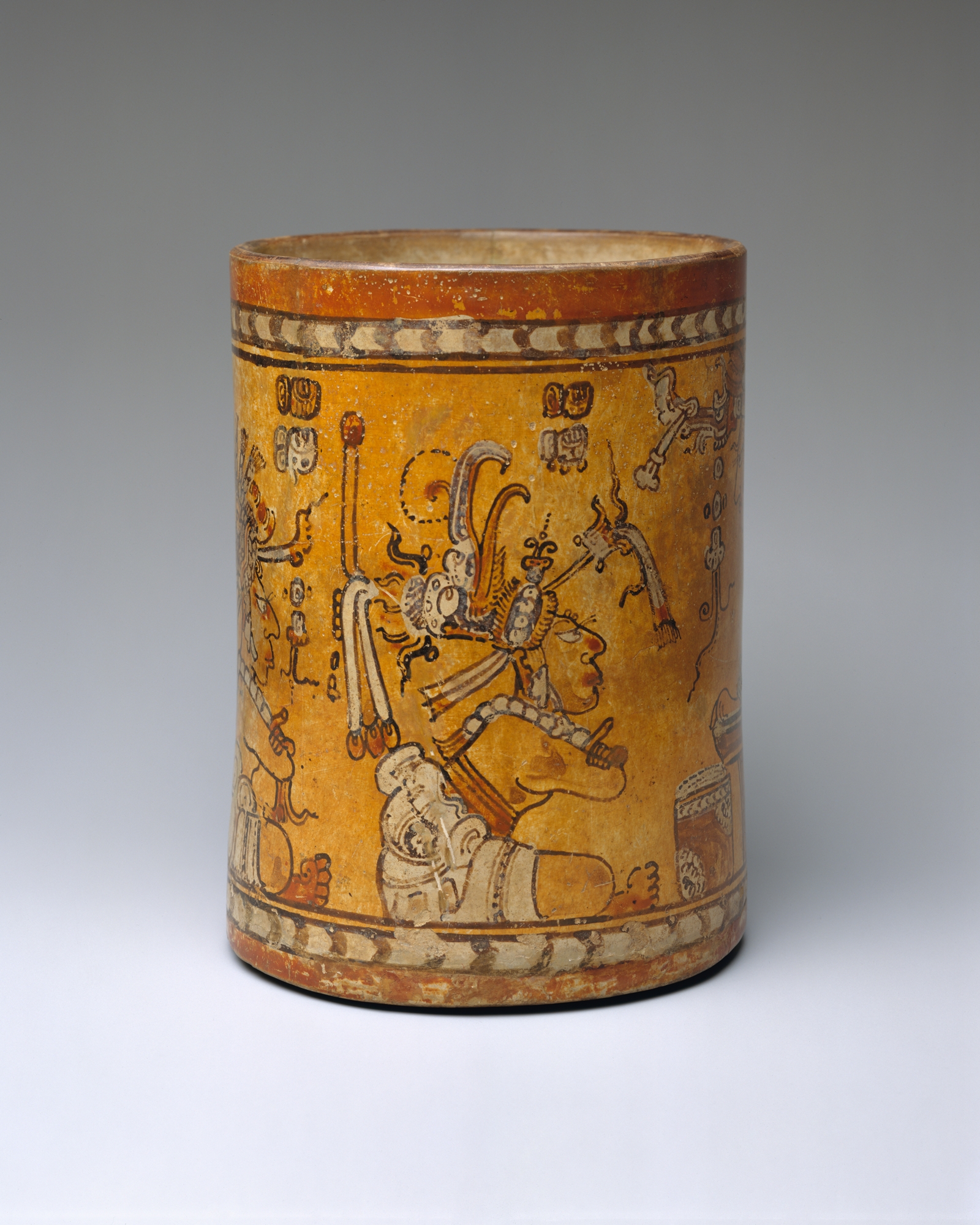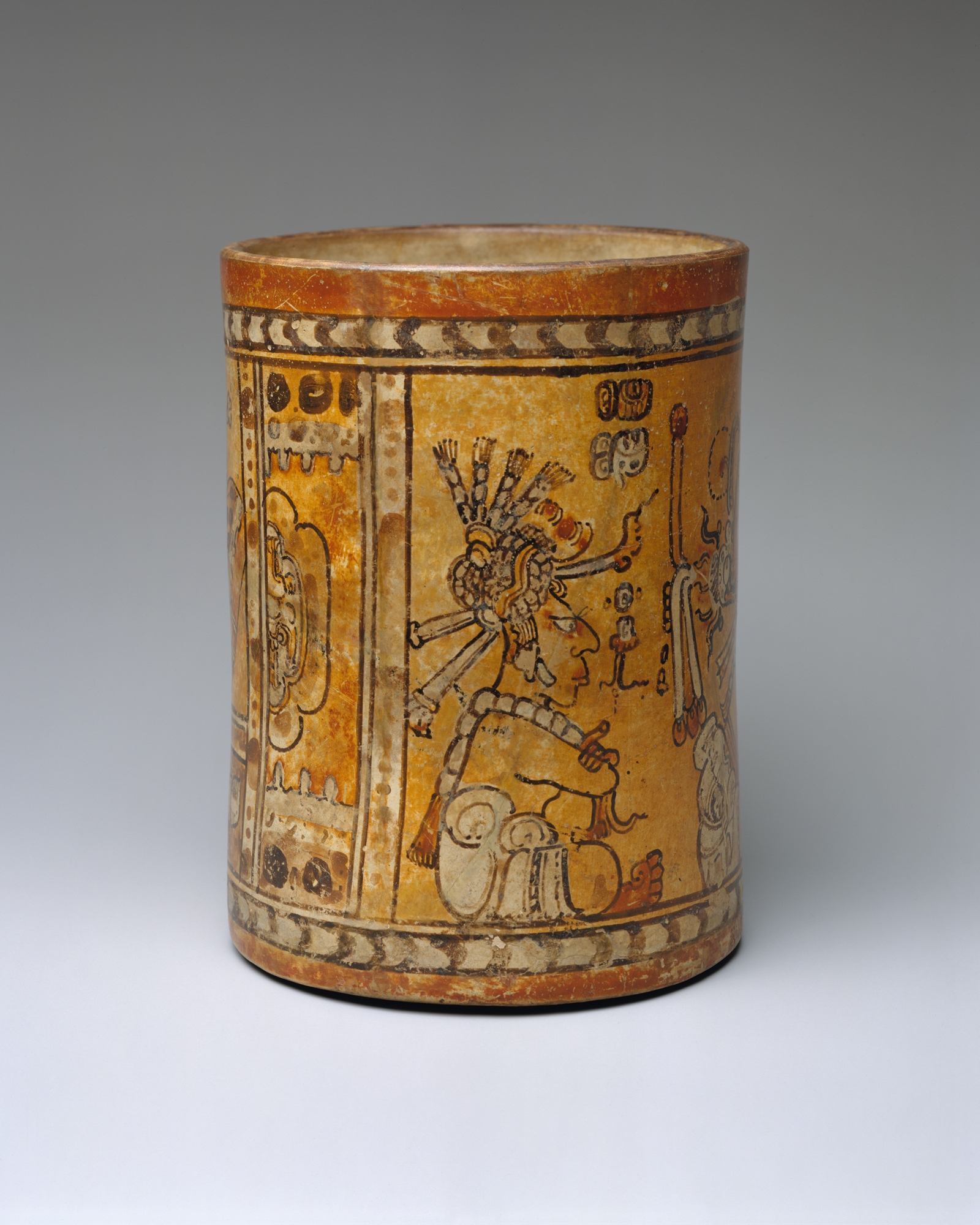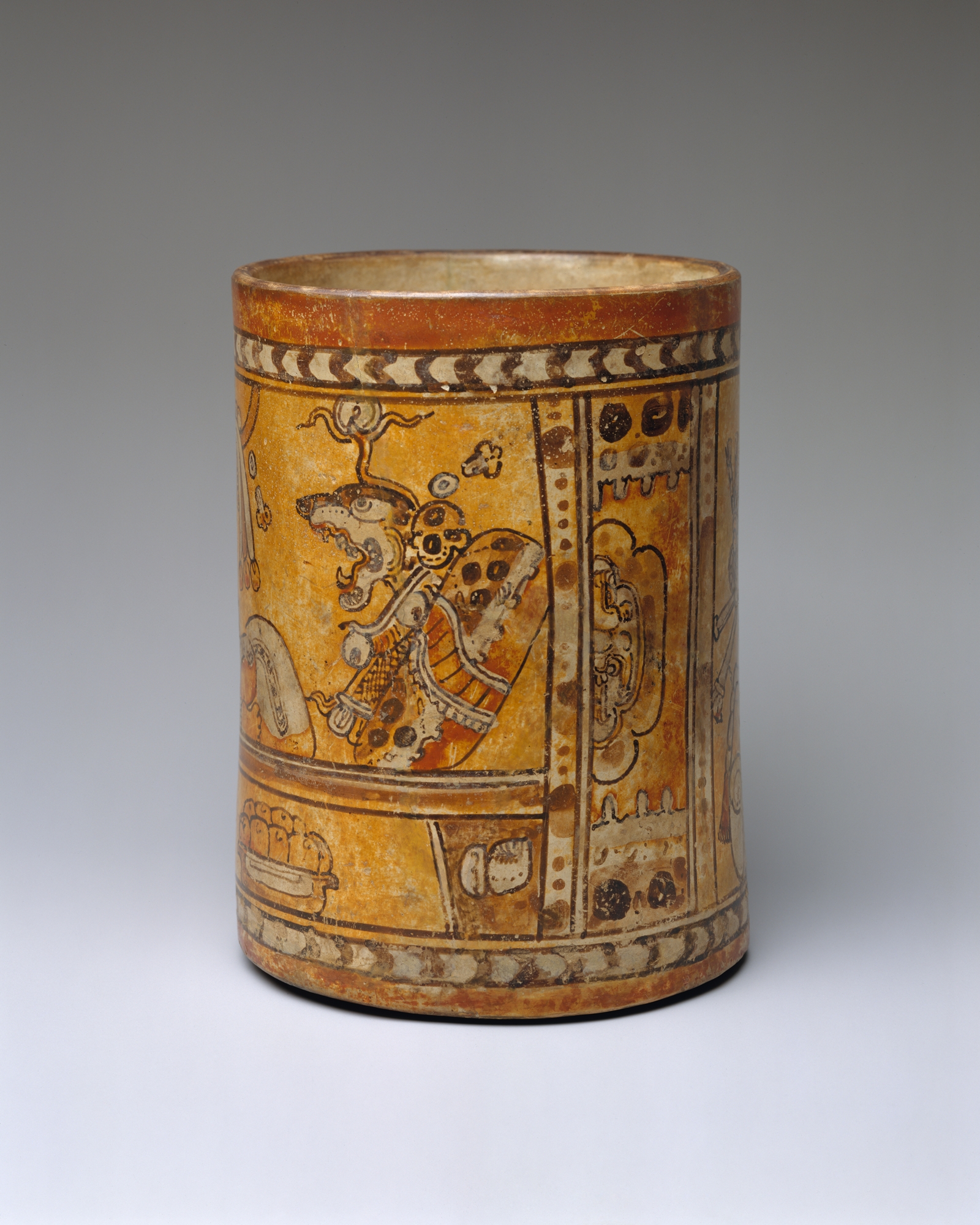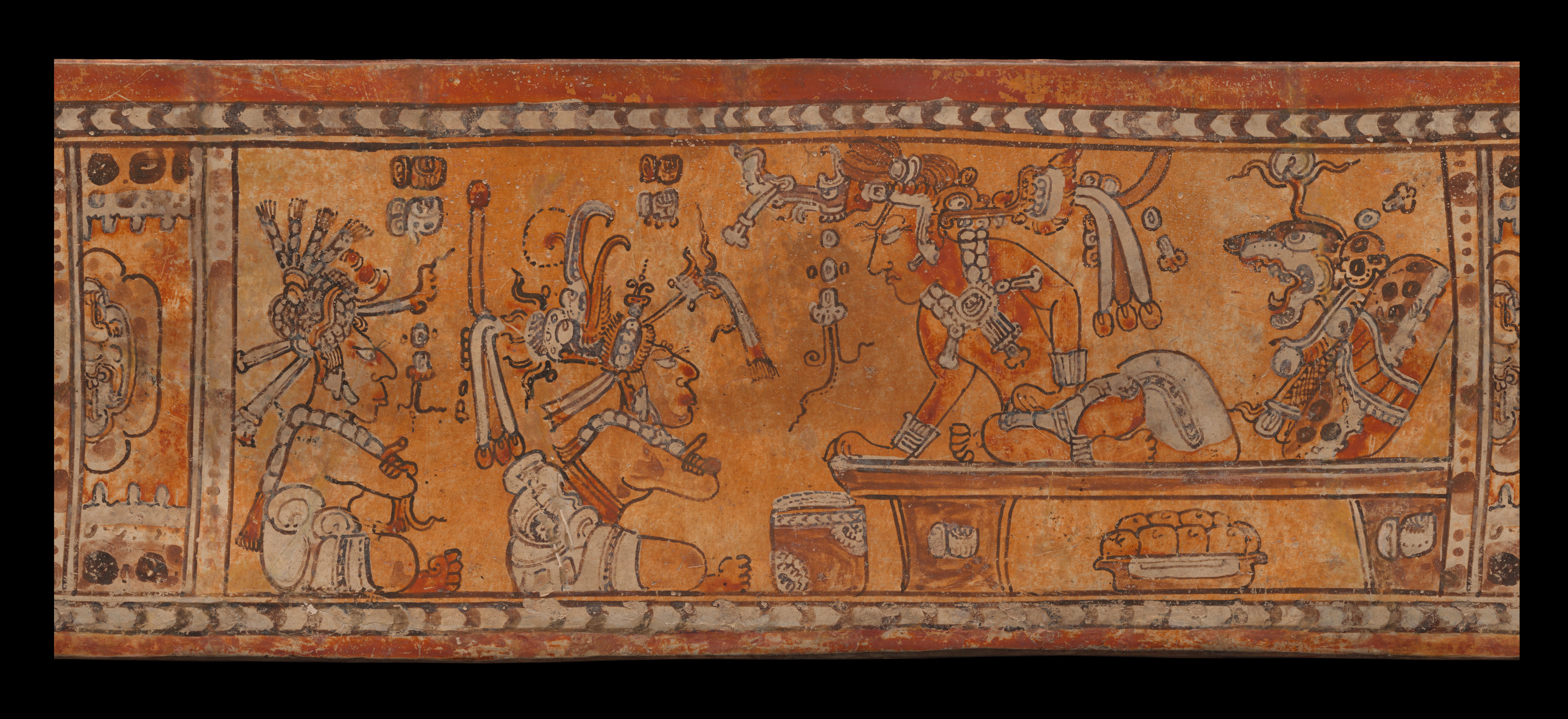Vessel, Throne Scene
Not on view
This polychrome Classic Maya drinking cup bears the finest example of a palace scene executed in the Chamá style. This painting tradition originated in the Alta Verapaz highlands in modern-day Guatemala. Chamá-style vases were a feature of courtly life on the western frontier of the Maya world in the eighth century. They were used in feasting, gift exchange, and funerary offerings. These few dozen vessels that survive represent a short-lived burst of artistic creativity at a time when major lowland cities were in political turmoil and on the brink of abandonment.
Shaped using the hand-built coil technique, the cylindrical vase contains a scene slip-painted on a yellow-orange background in red, brown, and white, outlined in black. A band of red paint encircles both the rim and the base of the vessel. Directly below, a black-and-white chevron motif frames the main scene within the red bands. The chevron pattern is the key marker of Chamá style. The artist outlined the elements of the palace scene in a calligraphic black line and masterfully shaded the humans and architectural elements.
A vertical column signals that the scene takes place in an architectural setting. The column is elaborately framed by dotted designs and contains a half-quatrefoil design in its center. The top and bottom of the column are decorated with jaguar pelts. Small protrusions on these are the remnants of the process whereby hunters tacked the skin to a board to dry it in the sun.
To the left of the column, seated upon a large throne, is the king who is the scene’s main protagonist. The throne’s trapezoidal legs contain hieroglyphs, though these, as with many Chamá style vases, are actually pseudo-glyphs. Pseudo-glyphs are meant to give the appearance of writing without actually being legible. These text-like images are common after the eighth century as literacy waned among speakers of the prestige Classic Mayan language.
A large ornate "traveling" bundle depicted in front of the throne is a pillow covered by a jaguar pelt and crowned with a headdress. A roaring jaguar forms the main part of the headdress resting on the pillow. It wears a head ornament of a water lily, a jade earring, and a necklace. The necklace is composed of feathers and representations of eyeballs, a sinister image associated with death gods. These types of portable thrones appear on other Chamá-style vases showing processions of rulers; rulers carried their royal court and kingly regalia with them as they visited their peers or subjects.
Gracefully leaning forward to address two visitors, the king wears a large white cotton loincloth. The garment is decorated with a band of black parallel lines; the excess fabric spills out behind him. He also dons a large pectoral, bracelets, anklets, and earflares. These ornaments are likely all made of jade, though any trace of fugitive green pigments is lost. The headdress of the king frames a topknot of hair and contains aquatic imagery of jawless reptiles and vegetation, part of which dangles in front of the face. Feathers extend behind him. His neck, torso, and arms are marked with a deep red, perhaps a depiction of royal body painting. The distinguished profile of the face, accented with delicate depictions of long eyelashes, enhances his regal presence.
Under the throne lie the gifts presented to the king by his visitors as a form of tribute. A lipped plate, full of either fruit or corn tamales, sits directly under the king. On the ground in between the king and the first visitor sits a cylindrical vessel full of a foaming liquid, either a type of fermented corn beverage or perhaps even savory chocolate. This depiction of a vessel features the same black-and-white chevron border as the vessel itself. This may be one of the very few self-referential depictions of a drinking cup in the corpus of Maya art.
The two visitors to the king sit cross-legged on the ground with folded arms, leaning slightly forward, in a deferential posture common in Maya art. The noble closest to the king wears a similar padded white loincloth and an elaborate headdress of a beaked water bird. The second tribute-bearer’s beaded headdress contains floral imagery with a vegetal element dangling in front of his face. The artist captured their stoic gazes as they await instruction from the sovereign who is about to address them. Pseudo-glyphs hover above the heads of both courtiers. .
A few examples of Chamá-style pottery are known from archaeological excavations conducted in the early 20th century by the University of Pennsylvania Museum of Archaeology and Anthropology. Chamá-style vases were produced by artists in a seemingly restricted area in the highlands of Guatemala around the drainage of the Río Chixoy during only one to two generations. The rulers on the Maya periphery commissioned vases with scenes of enthroned leaders, processions, battles, and groupings of mythological characters such as anthropomorphic bats and rabbits. The artist responsible for this vase depicted one of the few powerful political figures at a time when the Classic Maya political world had begun to unravel.
James Doyle, 2016
Published References
Coe, Michael D.
1973 The Maya Scribe and His World. New York, The Grolier Club. Cat. 13, pp. 40-41
Jones, Julie
2000 "Recent Acquisitions, A Selection: 1999–2000": The Metropolitan Museum of Art Bulletin, v. 58, no. 2 (Fall, 2000). P. 7
Further Reading
Danien, Elin C.
-2009 Painted Metaphors: Pottery and Politics of the Ancient Maya. Expedition vol. 51(1): 41-56.
-1998 The Chamá Polychrome Ceramic Cylinders in The University of Pennsylvania Museum. Unpublished dissertation, University of Pennsylvania.
-n.d. A reinterpretation of the Chamá vase. http://www.mayavase.com/com593.htm
Dieseldorff, E.P.
1904 A Pottery Vase with Figure Painting from a Grave in Chamá. U.S. Bureau of American Ethnology Bulletin 28: 639-44. Washington, Smithsonian Institution.
Reents-Budet, Dorie
1994 Painting the Maya Universe: Royal Ceramics of the Classic Period. Duke University Press, Durham and London. pp. 188-197.
Villacorta Calderó, José Antonio
1927 Arqueología guatemalteca. Guatemala City, Tipografía Nacional.
Due to rights restrictions, this image cannot be enlarged, viewed at full screen, or downloaded.
This artwork is meant to be viewed from right to left. Scroll left to view more.







